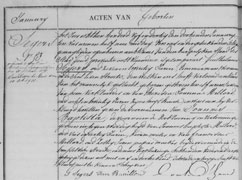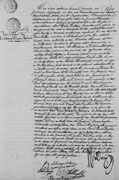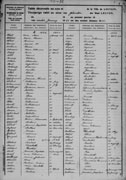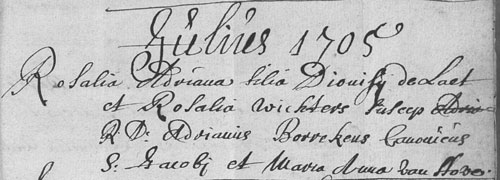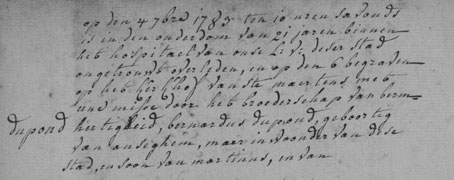Genealogy: how to get started?
Exploring one’s family history is a fascinating pastime. The State Archives provides online access to the most useful sources for this purpose – namely parish and civil status registers. The present guide lets you discover the basic sources and principles for genealogical research.
- Basic sources
- Access
- Climbing the family tree: Detailed finding aids online
- From family tree to family history
- Useful links
- Contact
Basic sources
When drawing a family tree you start with your own personal information from where you then climb up towards your parents, grandparents, great-grandparents, great-great-grandparents etc. For privacy reasons the data from the civil status records only become accessible after a given period of time: 50 years for death certificates, 75 years for marriage certificates and 100 years for birth certificates. Thus, for the first decades into the past, you will have to find information in other sources such as family registers, obituaries, in memoriams, epitaphs, …
Civil status registers
As soon as you find clues that are older than 50 years, you can also delve into the civil status registers. They are kept by the registrar of the municipal administration and contain the certificates of birth, marriage and death in chronological order. They are usually collected by type in individual series of records. In some cases however, different types of records are merged in one single series. The registers are produced in duplicate: one copy remains at the municipal administration, the other is handed over to the registry of the Court of First Instance, from where it is later transferred to the State Archives. The civil status registers begin in the years 1796-1797, which was year V of the former French Republican calendar.
Certificates of birth, marriage and death are legally valid proof and form the basic documentation for genealogical research after 1796.
-
Birth Certificates
Birth certificates contain last and first name(s), sex, and place, date and time of birth of the child. The certificate also mentions the names and place of residence of the parents. In some cases, their profession and age are also stated. Quite often the date of the certificate (the declaration of birth) is different from the date of birth.
-
Marriage certificates
Marriage certificates contain the first and last name(s), profession, age, place and date of birth, and place of residence of the future spouses. The first and last name(s), profession, age and place of residence of the parents and witnesses are also stated. It is important that the certificate mentions if and at which notary’s office a marriage contract was concluded.
Marriage documents
These are the documents that the registrar received to be able to assess whether or not all legal requirements are fulfilled to record the declaration: Extracts of birth certificates of bride and groom, extracts of death certificates of parents or former spouses, certificates of military service, records about consent to a marriage, and attestations about the conclusion of a marriage contract. Attention: There is only one file containing these marriage documents, which is conserved at the court and later transferred to the State Archives. Due to their volume, these marriage documents are not digitised and therefore not available online. For specific requests about these documents you can contact the State Archives repository in which they are conserved.
-
Indices
Every year, alphabetical indices are created for the civil status registers and processed at the court registry into so-called ten-year tables (1851-1860, 1861-1870, etc.). These indices are available online and form a useful tool for research, even though they are sometimes not strictly in alphabetical order, as the names are sorted based only upon the first letter of the last name.
As the indices for church and civil status registers were compiled per municipality only, you must first find out in which parish or municipality the certificate was registered. This is usually (for a marriage certificate) the place of residence of the bride. First, you search for the date and/or serial number of the record in the index or ten-year table, and then you look up the record in the indicated register. Using the names and dates found herein, you can go back to the indices and ten-year tables, and so on and so forth until you have found your oldest (known) ancestor.
Church registers
For records prior to 1796, you will have to consult the church registers (books of baptisms, marriages and funerals) written by the pastors. From the 16th century onwards, parish clerics were ordered to record baptisms, marriages, and deaths/funerals. Many of these registers were only started between 1610 and 1630 and scores of them were lost. Please note that very often the dates of baptism and funeral are mentioned and not the date of birth and death.
Church registers are usually written in (simplified) Latin and generally contain less standardised information than civil status registers:
In the last quarter of the 18th century, the recorded information became more detailed: name of the father of the spouses, respective origins of bride and groom, signatures of the spouses and witnesses, circumstances of death, … Baptisms of illegitimate children (illegitimi) were sometimes registered separately.
-
Other types of records
In addition to certificates of baptism, marriage and funerals, the church registers sporadically also contain other types of records. Lists of First Communion children, confirmands and penitents were held with indication of who were administered the sacraments of confirmation, eucharist and confession. The status animarum (state of souls) is an interesting source that provides an overview of the families living in a parish and information about the age of the family members, about whether or not the Easter duty was fulfilled etc.
-
Indices
In the second half of the 19th century, alphabetical finding aids were created per municipality to improve access to the church registers. These indices are sorted by family name. The family names usually refer to a date and a page or serial number in the register. In some cases, additional information is given, such as the name of the parents in the baptism certificate. The quality of these 19th-century indices is variable. In the past years, many volunteers have created new and more detailed finding aids, in which the children are listed per family with regard to baptisms for example.
As the indices for church and civil status registers were compiled per municipality only, you must first find out in which parish or municipality the certificate was registered. This is usually (for a marriage certificate) the place of residence of the bride. First, you search for the date and/or serial number of the record in the index or ten-year table, and then you look up the record in the indicated register. Using the names and dates found herein, you can go back to the indices and ten-year tables, and so on and so forth until you have found your oldest (known) ancestor.
Access
Church registers
All early modern church registers held by the State Archives and almost all registers kept elsewhere have been digitised and can be accessed online. In total, some 30,000 registers from the period prior to the introduction of the civil status registers (1796) concerning the current territory of Belgium are conserved. Information about lacunas are important and indicated on the website as best as possible in order to avoid futile research. The following factors must be taken into account however:
- Wars, fires and natural disasters cause a lot of loss. Especially the French Revolution and the two World Wars wreaked havoc. In many cases, it is impossible to know when or where the church registers were lost.
- Sometimes a chapel acquired full or partial parish rights only in the course of the 17th or 18th century. This explains why registers may only appear at a later moment in time. This is not a lacuna because of loss, but simply due to the late creation of a parish. In this case, it may be helpful to search the registers of the “mother parish” (from which the new parish was split).
- In the period 1570-1650 in particular, many countryside parishes did not have a minister. It was then the pastor from a neighbouring parish who recorded baptisms, marriages and deaths. In double parishes that were often served by one and the same pastor, this could take place in later times as well.
- Many cities had several parishes with individual registries.
- Beguine convents, monasteries, abbeys and hospitals sometimes had their own funeral registers.
- The army had military chaplains in service who baptised the children of soldiers, administered marriages and recorded deaths.
- An edict by empress Maria Theresia from 1778 made it mandatory to create copies of the church registers for the secular administrations (‘Theresian duplicates’). This explains why two series exist side by side for some parishes.
Civil status registers
The records held by the municipal administration can be accessed at the city hall in compliance with the applicable restrictions regarding publicity. A number of cities and municipalities have already digitised their civil status registers and provide online access to these scans. On behalf of the State Archives the records held by the Courts of First Instance are being scanned. In this long-term enterprise priority is given to those registers that have entered the public domain. Using the button ‘Date of update’ you can easily keep track of progresses in the digitisation process.
The civil status registers are also affected by lacunas.
- In some municipalities, both the copy at the municipal administration and its duplicate were destroyed (mostly during WWI or WWII).
- Changes in the course of the municipal borders can also cause problems. If you do not find a name in a particular municipality, be reminded that as from 1796 a number of municipalities were merged, split or their boundaries were modified. Please also note that information from the civil status registers bear on municipalities as they existed prior to the merger of 1977.
- Research in registers from the French period is not an easy task either. The introduction of the civil status registers in 1796 was met with quite some resistance from the clergy and the population (they were afraid of possible consequences with regard to compulsory military service). Many registers are damaged or contain gaps. Oftentimes the first records were simply registered in the church registers that had been handed over. In order to make up for the lacunas of the late 18th and early 19th century, one can consult population censuses (among others the census of year IV), militia lists and church registers from the period of the “Beloken Tijd” (created by pastors who continued to register although their registers had no probative force anymore).
Climbing the family tree: Detailed finding aids online
The 19th-century indices for the church registers and the ten-year tables for the civil status registers can also be accessed online. You can find them in the parish or municipality to which they refer. There may be significant differences in quality. It is important to note that the indices are often based on the municipalities as they existed in the 19th century. They can therefore bear on different parishes from the Ancien Regime.
In the past years, volunteers have made many genealogical sources and other sources accessible through databases. See among others the search option “Search persons”. This search engine often yields ready-to-use results, but it is advisable to check the records nevertheless.
Finally, there are a number of other indices and family reconstructions that cannot be proposed on the website of the State Archives for privacy reasons. In some cases, they can be found online however. In our reading rooms you often find a print version of these detailed finding aids. Here too, it is recommended to check the information.
From family tree to family history
Drawing a family tree is only the onset of genealogical research. The names and dates that were found form a framework that can be complemented by other sources. For many of the people listed in your “ahnentafel” or ancestors table a short biography can be compiled.
Concerning the 19th century, researchers should have a look at the population registers in particular. As from 1846 — in larger municipalities already during the French period— censuses were held per municipality every ten years. The results were recorded in a population register that was then complemented in the course of the following ten years. All family members and residents per quarter and street were recorded by name, place and date of birth, civil status, profession,... Population registers have a name register so that persons can be found easily. Although not all population registers were kept with the same diligence, they nevertheless form a unique source for research (attention: disclosure only after 120 years). Also of interest for 19th and 20th century family history: militia lists, inheritance declarations, tax registers, notarial deeds,...
Research into Ancien Regime poses a slightly higher challenge, but a number of interesting sources are available for this period too. Among others: records of aldermen and notaries, in which agreements between persons are registered: leases and rents, sales, loans and bails, marriage contracts, testaments,... Other interesting secondary sources for the 17th and 18th century are inventories drafted after a person’s death (lists of goods) and orphans’ accounts, population censuses, tax rolls, fief and rent registers, accounts of churches, tables and villages of the poor, case files,…
Most of these sources can be accessed in the reading rooms of the State Archives. A good starting point for research are the archives of the villages in which your ancestors lived. You can use the search engine “Search archives”. An increasing number of these documents is accessible online.
Useful links
- Our search engine ‘Search persons’
- Our search engine ‘Search archives’
- The Website of the Flemish genealogy organisation “Familiekunde Vlaanderen”
- The Website of the Brussels genealogy organisation „Familiekunde Brussel“
- The family history website “Familiegeschiedenis.be”
- The Website of FamilySearch
- The website of the genealogy organisation “GéniWal” (Généalogie Informatique Wallonie)
- Article (in Dutch) in Vlaamse Stam: The church registers. Indispensable source for every genealogy
- Article (in Dutch) in Bladwijzer: Birth, marriage and death. Church registers as source for your historical article
- Latin in church registers (vocabulary list compiled by volunteers at the State Archives of Bruges)
Contact
Do you have information about church registers that have not yet been digitised? Hove you discovered errors in the processing of the records?
Contact us!
